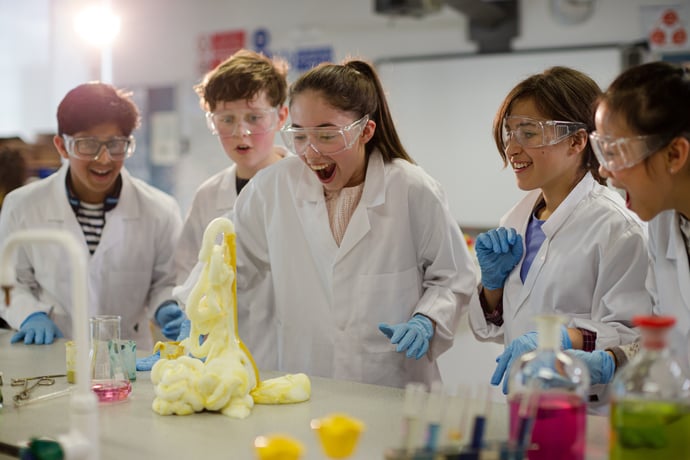
The act of storytelling has been used to communicate information for centuries. The science behind its success is clear. Storytelling helps audiences connect personally to the subject matter, remember key facts, understand complex ideas, and learn from one another’s experiences. Research from Uri Hasson, professor of psychology and neuroscience at Princeton University, showed recently that when we hear a story unfold, our brain waves start synchronizing with the storyteller’s.
Teachers see these results in their classrooms every day. When we connect classroom learning to real-world phenomena and engage students in critical thinking, hands-on learning, and personal reflection, we create the same type of high-level engagement as storytellers. When we challenge our students to ask questions, solve problems, and connect their classroom learning to real-world events, we use Next Generation Science Standards (NGSS) storylines to bring learning to life.
What are NGSS Science Storylines?
NGSS storylines include a sequence of lessons driven by the students’ questions as they interact with a new idea in different ways. Solving a problem and explaining a new phenomenon is the overarching goal, with steps linking to past knowledge across subjects and to real-world people and events. The storyline model provides a clear path towards mastery of core ideas while allowing students to chart their own way, work together to overcome obstacles and share skills and ideas they’ve learned in other lessons and subjects with their classmates.
KnowAtom’s basic five-part framework aligns with the storyline instructional model. At the core of NGSS storylines is student-centered learning. As science teachers introduce complex topics, storylines allow students to take ownership of their learning by asking questions, investigating, and developing their own path to understanding. NGSS storylines inject creativity and encourage a personal connection to the subject by linking it to real-world phenomena and weaving in concepts from different subjects, from reading comprehension to research techniques, and historical figures to mathematics.
With NGSS Storylines, Students are the Authors of Their Own Story
Problem-solving is at the heart of storylines, just like the heroes of our well-loved fairy tales solve challenges throughout their journeys. Using storylines asks students to identify their own questions, collect their own data, and make their own conclusions, just like the characters in a story change their path as they encounter new characters, learn new information, and make their own decisions along the way.
With storylines, students work on the same topic for more than one day and track their own progress. Students learn to value the process as well as the conclusion, just like real-world scientists and engineers. They are working together, practicing critical thinking skills, and using classroom routines to find their own way along the story. The students self-assess their own progress and ask for help when they hit a bump in the road.
With storylines, a student’s curiosity powers the story:
- They are rewarded for imagination and creativity.
- They are motivated to help their group answer questions they chose themselves.
- They learn from their peers’ experiences and knowledge.
- They can make mistakes and learn from them, change their questions, improve their understanding, and reach new conclusions based on what they learn.
When holistic assessment is incorporated throughout the learning process, the learning environment more closely mirrors scientific endeavors in the real world. With storylines, students work together, build on their knowledge with hands-on investigation, and hold responsibility for their progress.
KnowAtom Lesson Routine and NGSS Storylines
These are the five parts of a KnowAtom storyline, or lesson routine, that usually takes place over 7 to 10 days:
- Picture-thinking with Non-fiction Reading – Students connect with phenomenon-concept, concept-self, or concept-world
- Socratic Dialogue – Classroom discussion unpacks students’ wows, wonders, and connections; and transitions to related questions and problem-solving activities
- Team experiment/prototype planning – Students create a plan to answer a problem and then question phenomena using scientific or engineering design processes
- Hands-on experimentation and data gathering – Students are in the lead, using student-designed plans
- Evidence-based conclusions – Teams form evidence-based conclusions and share them with the class, coming to a consensus as a group
When teachers use storylines throughout the KnowAtom five-part lesson process, they are empowering students to think like engineers and scientists every day by questioning and experimenting together.
NGSS Storylines in Action with KnowAtom
In 6th grade, students tackle the big ideas of gravity and motion. They overcome common misconceptions like Gravity only exists on Earth, and Energy can be created and destroyed with hands-on learning activities. These students become scientists and engineers in their classroom, tackling this demanding topic by investigating their own questions and using their current knowledge to solve problems, including:• The relationship between gravity and motion, including how gravitational potential energy transforms into kinetic energy within different energy systems.
- Connecting gravity and motion with real-world experiences, including visiting an amusement park, playing pool, and testing a new roller coaster.
- Investigating a bouncy ball's drop and rebound heights and comparing the amount of energy transferred in a collision by moving marbles of different masses.
- Developing a visual model to show how potential energy stored in a roller coaster changes when cars are at different heights on the track while learning about the history of roller coasters and the engineering principles behind water parks and amusement park rides.
- Learning about Isaac Newton, the laws of motion, and how they impact games like pool, and Mae Jemison, the first African American female astronaut. In the video “The Cosmic Dance,” Mae Jemison compares the study of science to the arts.






